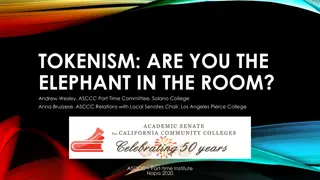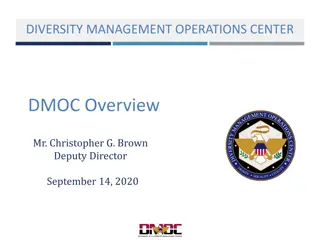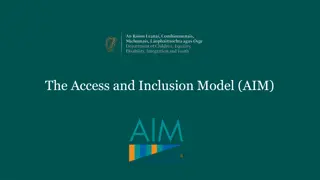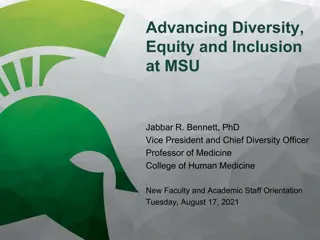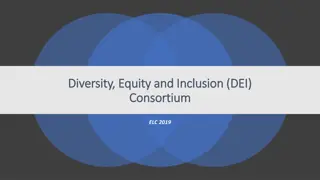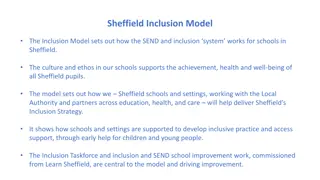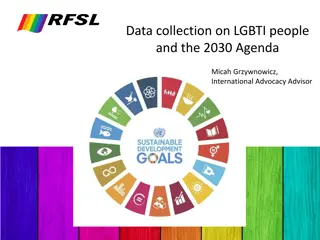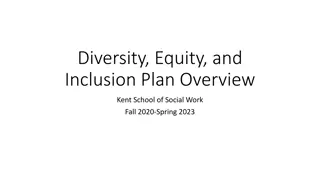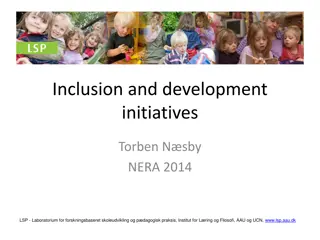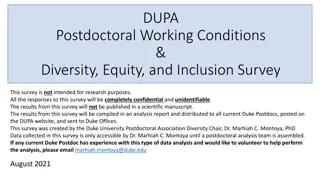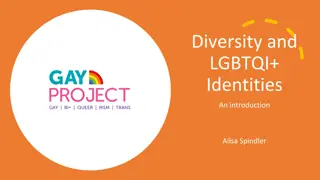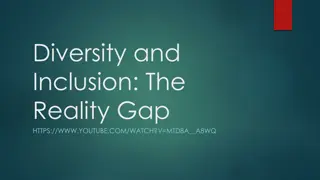Promoting Diversity and Inclusion in Work: An Analysis
Affirmative action has been a subject of debate in the United States, with its impact on workplace diversity and inclusion being both praised and criticized over the years. From its historical roots to current legal challenges, its appropriateness in achieving diversity goals is under scrutiny. The article delves into the complexities of affirmative action and its role in fostering a diverse and inclusive work environment.
Download Presentation

Please find below an Image/Link to download the presentation.
The content on the website is provided AS IS for your information and personal use only. It may not be sold, licensed, or shared on other websites without obtaining consent from the author.If you encounter any issues during the download, it is possible that the publisher has removed the file from their server.
You are allowed to download the files provided on this website for personal or commercial use, subject to the condition that they are used lawfully. All files are the property of their respective owners.
The content on the website is provided AS IS for your information and personal use only. It may not be sold, licensed, or shared on other websites without obtaining consent from the author.
E N D
Presentation Transcript
AFFIRMATIVE ACTION How Appropriate is it to Rely on it to Promote Diversity and Inclusion in Work?
Affirmative action in US Tahl Tyson LITTLER, USA
United States Civil Rights Timeline 1865-1979 1865 1866-1960 Congress passes first civil rights law but Enforcement withers after 1877, when Reconstruction ends. Jim Crow laws to segregate citizens by race enacted in the South. 1961-1964 Affirmative action is born Brown v. Board of Education case leads to the desegregation of public schools 1970s 1979 March 1961 Kennedy issues first affirmative action directive 1964-1965 Civil Rights Act of 1964 1969-1979 Affirmative action booms Slavery is outlawed in 1865, emancipating 4 million Black men, women and children. Colleges adopt affirmative action 1978 Regents of the University of California v. Bakke, Supreme Court ruling that universities cannot use quotas but can factor race into admissions decisions to promote campus diversity. Voluntary affirmative action plans survive Bakke
United States Civil Rights Timeline 1981-Current 1981-1989 President Ronald Reagan presses to end affirmative action, promoting colorblindness 1990-1999 Lawsuits challenge affirmative action practices in government, business and education. Some states e.g. CA, WA, pursue bans of affirmative action as discriminatory (but federal ban fails) Highest courts debate whether diversity is a public good. Private companies start training programs to help workers recognize unconscious bias. July 1992 Protections for disabled employees take effect (Americans with Disabilities Act 1990) 2000-2010 Divisions over diversity increase 2003 2011-Present 2020 George Floyd, a Black man, is murdered by a White police officer June 2016 Fisher v. University of Texas June 2020 DEI boom in private companies June 2023 Supreme Court bars race- based admissions Current DEI under attack by conservative legal activists. Legislation proposed targeting DEI policies in higher education are pending across the country. Companies, law firms, facing challenges to diversity policies. DEI becomes an issue on 2024 Presidential campaign trail. The University of Michigan cases
Does SFFA decision affect workplace DEI? SFFA DECISION Goal of diversity can no longer justify using race as a plus factor in college admissions Title VI of the Civil Rights Act of 1964 Equal Protection Clause of the Fourteenth Amendment of the Constitution WORKPLACE Plus factor unlawful absent a remedial justification- diversity already not sufficient Title VII of the Civil Rights Act of 1964 42 U.S.C. 1981 of the 1866 Civil Rights Act, which covers contracts EEOC Regulations But Title VI language similar to that of Title VII concurring opinion (Justice Gorsuch): [b]oth Title VI and Title VII codify a categorical rule of individual equality, without regard to race Conservative nonprofits lawsuits targeting employer DEI programs (Edward Blum) Most employers still committed to, but evolving DEI Employers should follow EEOC regs
What is Affirmative Action in US Employment? Title VII prohibits employment discrimination on the basis of race, color, national origin, sex and religion. In order for employers to engage in race- or gender-conscious decisions, they must: have a written plan engage in a reasonable self-analysis of the relevant employment practice, such as a specific hiring or promotion practice have a reasonable basis to conclude from the self-analysis that the relevant employment practice has had an adverse effect on previously excluded groups or groups whose opportunities have been artificially limited include reasonable action in the plan that is narrowly tailored to solve the problem identified without placing unnecessary restrictions on the workforce as a whole ensure the plan is maintained no longer than necessary to achieve the plan s objective.
Permissible workplace actions & current recommendations (US) Identify and eliminate specific barriers in the hiring process Seek out alternative and wider talent pools focus on outreach and recruitment, expanding pallet of candidates Conduct data analytics under privilege! to do a voluntary program you have to admit there is something wrong -data creates potential basis for discrimination lawsuit Low risk for potential litigation: programs that offer mentorship widely to anyone at the company ERGs (employee resource groups) that do not exclude anyone High risk for potential litigation: using race or gender as a plus factor to improve workplace diversity quotas: illegal even for federal contractors; positive discrimination only allowed if a conciliation decree Rooney Rule - (originally used by NFL to reserve interview places for minorities) under attack a women-only training program funding scholarship/fellowship/program to create hiring pipeline based on protected categories
Affirmative action in Belgium Philippe De Wulf ALTIUS, Belgium
When is Affirmative Action allowed for employers in Belgium? Belgian Anti-discrimination Acts: A direct or indirect distinction based on one of the protected criteria does not constitute discrimination if it is based on an affirmative action measure 4 conditions must be complied with: there must be an apparent inequality the elimination of this inequality should be identified as an objective to be promoted the affirmative action measure must be temporary and must disappear once the intended objective has been achieved (note: not specifically required under EU law) the affirmative action measure must not unduly restrict other people's rights A Royal Decree of 11 February 2019 determines the situations in which and conditions under which an affirmative action measure may be taken
The Belgian Royal Decree Affirmative Action of 11 February 2019 An employer has the option to: Heavy procedure: negotiating CBA with unions or possibility for employees to make remarks (Deed of Accession) Plan must include the following information: - Proof of the existence of a manifest inequality (statistics, data mining, etc.) - Objective and practical implementation of the plan - Duration: the measures must cease as soon as the objective is reached with a maximum of 3 years - The measures must be appropriate and necessary Approval by the Employment Minister Only for the private sector LEGAL CERTAINTY Provide for an Affirmative Action Plan by CBA or Deed of Accession to be approved by the Employment Minister Approved Plans do not constitute discrimination Shift of liability: Government liability if the plan is successfully challenged in court by an employee OR Can be communicated to the Employment Minister for information purposes (not approval) Allowed if the measures comply with the 4 conditions of the Anti-DiscriminationActs Take Affirmative Action measures outside a CBA or Deed of Accession NO LEGAL CERTAINTY that these measures will not be regarded as discrimination
Affirmative action in Great Britain Tahl Tyson LITTLER, USA
Great Britain: Positive Action versus Positive Discrimination Two types of lawful positive action: General positive action to reduce disadvantage for people with protected characteristics Hiring tie-breaker Voluntary, motivated by gender and ethnicity pay gap reporting Must be proportionate consider alternative measures before resorting to positive action Do NOT use interview or hiring quotas Ethnicity definitions and data protection challenges
Great Britain Unlawful discrimination examples: automatically recruiting or promoting based on protected characteristic setting quotas reserving places on interview panels schemes to benefit those with a particular protected characteristic, without any evidence that the group in question is at a disadvantage or has different needs Recommendations: Obtain evidence why positive action needed ensure data protection compliance consider meaningful ethnicity categories Have a timeline for delivering actions how progress will be measured Consult with employees



